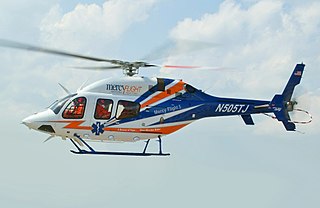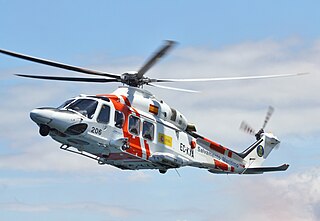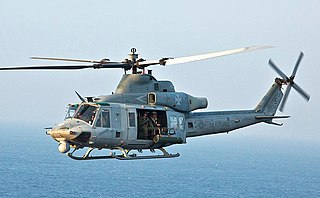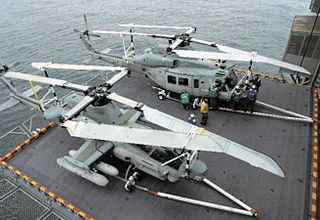
The Bell UH-1 Iroquois is a utility military helicopter designed and produced by the American aerospace company Bell Helicopter. It is the first member of the prolific Huey family, as well as the first turbine-powered helicopter in service with the United States military.

Bell Textron Inc. is an American aerospace manufacturer headquartered in Fort Worth, Texas. A subsidiary of Textron, Bell manufactures military rotorcraft at facilities in Fort Worth, and Amarillo, Texas, United States as well as commercial helicopters in Mirabel, Quebec, Canada.

The Bell CH-146 Griffon is a multi-role utility helicopter designed by Bell Helicopter Textron as a variant of the Bell 412EP for the Canadian Armed Forces. It is used in a wide variety of roles, including aerial firepower, reconnaissance, search and rescue and aero-mobility tasks. The CH-146 has a crew of three, can carry up to ten troops and has a cruising speed of 220–260 km/h.

The Bell AH-1 SuperCobra is a twin-engined attack helicopter that was developed on behalf of, and primarily operated by, the United States Marine Corps (USMC). The twin Cobra family, itself part of the larger Huey family, includes the AH-1J SeaCobra, the AH-1T Improved SeaCobra, and the AH-1W SuperCobra.

The Bell 206 is a family of two-bladed, single- and twin-engined helicopters, manufactured by Bell Helicopter at its Mirabel, Quebec, plant. Originally developed as the Bell YOH-4 for the United States Army's Light Observation Helicopter program, it was not selected by the Army. Bell redesigned the airframe and successfully marketed the aircraft commercially as the five-place Bell 206A JetRanger. The new design was eventually selected by the Army as the OH-58 Kiowa.

The Bell 412 is a utility helicopter of the Huey family manufactured by Bell Helicopter. It is a development of the Bell 212, with the major difference being the composite four-blade main rotor. It is a twin-turbine helicopter that has been popular on the civilian and military markets, and major users include Canada, Italy, and Japan. Several hundred have been produced since its introduction in 1979, and several iterations of upgrades and variations have been produced such as with upgraded cockpit electronics.

The Bell 429 GlobalRanger is a light, twin-engine helicopter developed by Bell Helicopter and Korea Aerospace Industries. The first flight of the prototype took place on February 27, 2007, and the aircraft received type certification on July 1, 2009. The Bell 429 is capable of single-pilot IFR and Runway Category A operations.

The EurocopterUH-72 Lakota is a twin-engine helicopter with a single, four-bladed main rotor. The UH-72 is a militarized version of the Eurocopter EC145, built by American Eurocopter, a division of Airbus Group, Inc. Several hundred UH-72 of various types have entered service by the 2020s since their introduction in 2006.

The AgustaWestland AW139, now known as the Leonardo AW139, is a 15-seat medium-sized twin-engined helicopter developed and produced by the Anglo-Italian helicopter manufacturer AgustaWestland, now part of Leonardo. It is marketed at several different roles, including VIP/corporate transport, military use, offshore transport, firefighting, law enforcement, search and rescue, emergency medical service, disaster relief, and maritime patrol.

The Bell 214 is a medium-lift helicopter derived from Bell Helicopter's ubiquitous UH-1 Huey series. The Bell 214ST shares the same model number, but is a larger, much-modified twin-engine derivative.

The Bell Model 309 KingCobra was an experimental attack helicopter developed by Bell Helicopter, based on the Bell AH-1 Cobra.

The Bell UH-1Y Venom is a twin-engine, 4-blade, medium-sized utility helicopter built by Bell Helicopter under the H-1 upgrade program of the United States Marine Corps. One of the latest members of the numerous Huey family, the UH-1Y is also called "Yankee" for the NATO phonetic alphabet pronunciation of its variant letter. Bell was originally to produce UH-1Ys by rebuilding UH-1Ns, but ultimately used new built airframes. In 2008, the UH-1Y entered service with the Marine Corps and also began full-rate production. The new UH-1 variant replaced the USMC's UH-1N Twin Huey light utility helicopters, introduced in the early 1970s. The helicopter were ordered by the Czech Republic and the helicopter is in production in the early 2020s.

The Bell 204 and 205 are the civilian versions of the UH-1 Iroquois single-engine military helicopter of the Huey family of helicopters. They are type-certificated in the transport category and are used in a wide variety of applications, including crop dusting, cargo lifting, Forestry Operations, and aerial firefighting.

The Bell UH-1N Twin Huey is a medium military helicopter designed and produced by the American aerospace manufacturer Bell Helicopter. It is a member of the extensive Huey family, the initial version was the CUH-1N Twin Huey, which was first ordered by the Canadian Forces in 1968.

The Bell 214ST is a medium-lift, twin-engine helicopter descended from Bell Helicopter's ubiquitous UH-1 Huey series. Though it shares a type number with the somewhat-related Bell 214, the 214ST is larger and of quite different appearance.

The Bell UH-1 Iroquois military helicopter, first introduced in 1959, is the first production member of the prolific Huey family of helicopters, and was itself developed in over twenty variants, which are listed below.

The Sikorsky XH-39, developed by Sikorsky Aircraft in 1954, was the U.S. Army's first turbine-powered helicopter. It was fast and innovative, but ultimately rejected by the United States Army in favor of the Bell UH-1 Iroquois.

The Bell Huey family of helicopters includes a wide range of civil and military aircraft produced since 1956 by Bell Helicopter. This H-1 family of aircraft includes the utility UH-1 Iroquois and the derivative AH-1 Cobra attack helicopter series and ranges from the XH-40 prototype, first flown in October 1956 to the 21st-century UH-1Y Venom and AH-1Z Viper. Although not flown in military service in the USA, the Bell 412 served in Canada and Japan, and like the UH-1Y is a twin engine four rotor design based on the Bell 212.

The H-1 upgrade program is the United States Marine Corps's program to develop the AH-1Z Viper and UH-1Y Venom military helicopters to replace its aging fleets of AH-1W SuperCobras and UH-1N Twin Hueys. The contract was awarded in 1996 to Bell Helicopter, the original manufacturer of both aircraft, to design the new airframes as modernized attack and utility helicopters with considerable design commonality, to reduce operating costs.

The Pratt & Whitney Canada PT6T Twin-Pac is a turboshaft engine designed for helicopters. Manufactured by Pratt & Whitney Canada, its first application was in the Bell 212 and UH-1N Twin Huey helicopter family. The PT6T Twin-Pac consists of two PT6A power turbines driving a common output reduction gearbox, producing up to 2,000 hp at 6,000 rpm. The engine is designated T400 by the U.S. military.

























